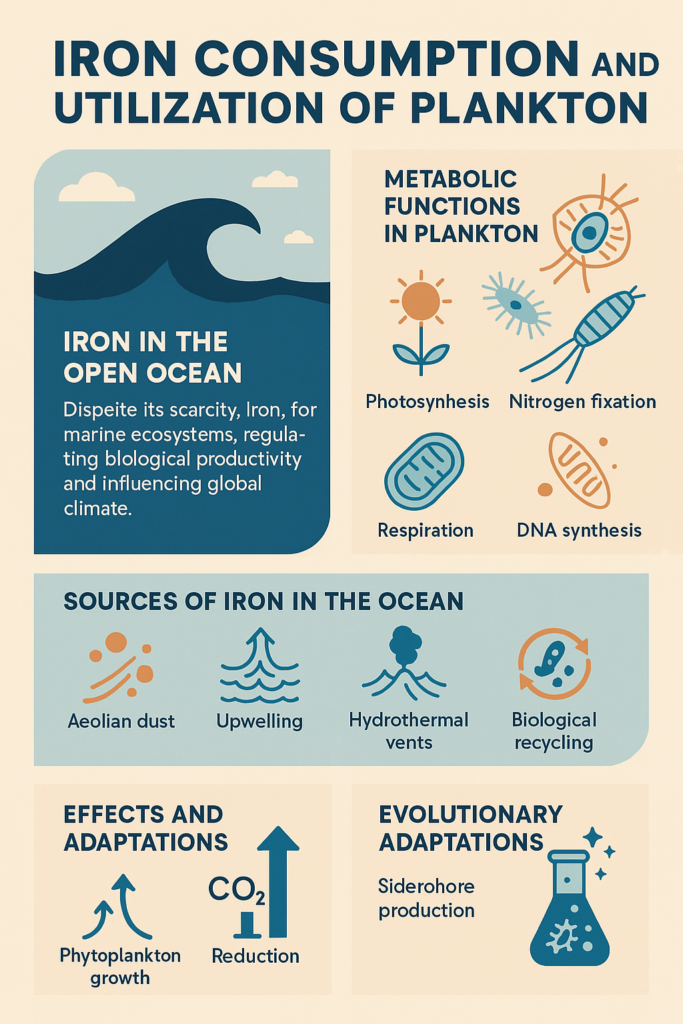In the vast, seemingly boundless stretches of the open ocean—especially the oligotrophic gyres and high-nutrient, low-chlorophyll (HNLC) regions—life is surprisingly dependent on a microscopic trace metal: iron (Fe). Though abundant in the Earth’s crust, iron is exceedingly scarce in seawater. And yet, it plays an outsized role in marine ecosystems, regulating biological productivity, influencing atmospheric CO₂ concentrations, and shaping the global climate. Understanding how organisms like plankton and other marine animals utilize iron opens a window into the intimate link between trace metals and planetary health.

Why Iron Matters in the Ocean
Iron is essential for virtually all living organisms because it serves as a cofactor in enzymes and proteins critical to metabolic processes. In oceanic phytoplankton—microscopic photosynthetic organisms that form the base of the marine food web—iron is vital for:
- Photosynthesis (via components like ferredoxin and cytochrome complexes),
- Nitrogen fixation (especially in cyanobacteria such as Trichodesmium),
- Respiration (as part of cytochromes and iron-sulfur clusters),
- DNA synthesis, and
- Chlorophyll production.
Despite its importance, iron is one of the most limiting nutrients in the open ocean, particularly in HNLC regions like the Southern Ocean, subarctic Pacific, and parts of the equatorial Pacific. Here, despite ample macronutrients like nitrate and phosphate, phytoplankton growth is stunted due to iron deficiency.
Plankton and Iron: A Metabolic Partnership
Phytoplankton require iron in minuscule concentrations, often in the range of picomoles per liter. However, their metabolic demand is precise and non-negotiable. When iron is available, primary productivity in these regions can spike dramatically, resulting in massive phytoplankton blooms. These blooms draw down atmospheric carbon dioxide through photosynthesis and can fuel rich food webs stretching up to whales.
Iron limitation affects not only growth rate but also biochemical pathways. For instance:
- Under iron scarcity, phytoplankton switch from iron-rich ferredoxin to iron-free flavodoxin for electron transport.
- They reduce photosynthetic efficiency and carbon fixation capacity.
- Nitrogen-fixing cyanobacteria are particularly sensitive, as nitrogenase, the enzyme that converts inert N₂ gas into bioavailable ammonia, contains iron and molybdenum. Iron limitation can thus constrain nitrogen fixation, compounding nutrient limitations.
Zooplankton and Higher Organisms: Iron Transfer and Demand
Iron also cycles through the oceanic food web. Zooplankton—tiny drifting animals like copepods and krill—consume phytoplankton, and in doing so, acquire iron. Some iron is retained for metabolic processes like mitochondrial respiration, while much is recycled via excretion or the production of fecal pellets, contributing to the biological pump—the process by which carbon and nutrients are transported from surface waters to the deep sea.
Larger organisms like fish, squid, and even whales accumulate iron by consuming lower trophic levels. However, their role in the biogeochemical cycling of iron is more indirect:
- Whales, for example, play a critical part in what’s known as the “whale pump.” By diving to feed at depth and defecating near the surface, they help redistribute iron upward, fertilizing phytoplankton in iron-starved surface waters.
Sources of Iron in the Ocean
Since seawater is naturally low in soluble iron, its availability largely depends on:
- Aeolian dust from deserts (especially the Sahara, Gobi, and Australian Outback),
- Upwelling of deep, iron-rich waters,
- Hydrothermal vents along mid-ocean ridges,
- Continental runoff (though minimal in mid-ocean regions),
- Biological recycling (through grazing, decomposition, and excretion).
In HNLC zones, iron input from dust and upwelling can trigger profound biological responses. For instance, experiments such as iron fertilization trials (like those conducted in the Southern Ocean) have shown that small amounts of iron can stimulate large-scale phytoplankton blooms, drawing down CO₂ and altering regional ecosystems.
The Iron Paradox and Global Carbon Cycles
This tight coupling between iron and photosynthetic activity links marine biogeochemistry to global climate regulation. When phytoplankton bloom due to increased iron, they sequester atmospheric CO₂ through photosynthesis. Some of this organic carbon sinks to the ocean floor, effectively removing it from the short-term carbon cycle—a mechanism with implications for geoengineering and climate change mitigation.
However, this process is complex and controversial:
- Not all carbon sinks permanently; much is remineralized by bacteria and returned to the atmosphere.
- Over-fertilization could disrupt food webs, create anoxic zones, or lead to the proliferation of harmful algal species.
Thus, iron is both a keystone nutrient and a potential lever for climate intervention—but one that must be pulled with caution.
Evolutionary Adaptations to Iron Scarcity
Marine microorganisms have evolved remarkable strategies to cope with iron limitation:
- Siderophore production: Many bacteria produce iron-chelating compounds to scavenge iron from the environment.
- Genomic streamlining: Some organisms, like Prochlorococcus, minimize their iron needs by reducing the number of iron-dependent proteins.
- Protein substitutions: Swapping out iron-heavy enzymes for alternatives, as mentioned earlier with flavodoxin, helps economize iron use.
These adaptations underscore how deeply the ocean’s biosphere is shaped by iron’s scarcity—and how metabolic strategies are rooted in elemental availability.
Conclusion: A Tiny Metal with a Titanic Role
Iron may be a trace element, but its impact on ocean ecosystems, global nutrient cycling, and planetary climate is profound. From fueling planktonic photosynthesis to modulating atmospheric CO₂, iron connects the microscopic and the planetary in a tightly interwoven web. In the open ocean, where every atom counts, iron is less a luxury than a lifeline—one that continues to shape the biosphere in quiet but extraordinary ways.
Understanding and respecting this dynamic is essential as we face global challenges like climate change, biodiversity loss, and ocean deoxygenation. Iron is not just a chemical element; it is a key player in Earth’s life-support system.

Leave a Reply